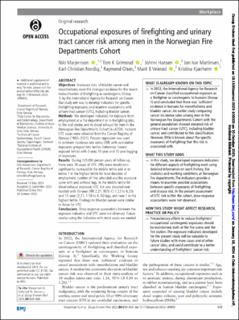| dc.contributor.author | Marjerrison, Niki | |
| dc.contributor.author | Grimsrud, Tom Kristian | |
| dc.contributor.author | Hansen, Johnni | |
| dc.contributor.author | Martinsen, Jan Ivar | |
| dc.contributor.author | Nordby, Karl-Christian | |
| dc.contributor.author | Olsen, Raymond | |
| dc.contributor.author | Veierød, Marit Bragelien | |
| dc.contributor.author | Kjærheim, Kristina | |
| dc.date.accessioned | 2024-01-16T09:27:11Z | |
| dc.date.available | 2024-01-16T09:27:11Z | |
| dc.date.created | 2023-12-05T15:49:31Z | |
| dc.date.issued | 2023 | |
| dc.identifier.citation | Occupational and Environmental Medicine. 2023, 80 (12), 659-666. | |
| dc.identifier.issn | 1351-0711 | |
| dc.identifier.uri | https://hdl.handle.net/11250/3111694 | |
| dc.description.abstract | Objectives Increased risks of bladder cancer and mesothelioma were the strongest evidence for the recent reclassification of firefighting as carcinogenic (Group 1) by the International Agency for Research on Cancer. Our study aim was to develop indicators for specific firefighting exposures and examine associations with urinary tract cancer (UTC), including bladder cancer. Methods We developed indicators for exposure from employment at a fire department or in firefighting jobs, to fire and smoke, and to diesel exhaust for men in the Norwegian Fire Departments Cohort (n=4250). Incident UTC cases were obtained from the Cancer Registry of Norway (1960–2021). Poisson regression was used to estimate incidence rate ratios (IRR) with cumulative exposures grouped into tertiles (reference: lowest exposed tertile) with 0-year, 10-year and 15-year lagging of exposures. Results During 125 090 person-years of follow-up, there were 76 cases of UTC. IRRs were mostly non-significantly increased in the middle tertile and at or below 1 in the highest tertile for total duration of employment, number of fires attended and fire exposure score with and without lags. In the middle tertile for diesel exhaust exposure, UTC risk was elevated over twofold with 10-year (IRR 2.27, 95% CI 1.22 to 4.20) and 15- year (2.21, 1.18 to 4.16) lags, and near 1 in the highest tertile. Findings for bladder cancer were similar to those for UTC. Conclusions Dose-response associations between the exposure indicators and UTC were not observed. Future studies using the indicators with more cases are needed. | |
| dc.language.iso | eng | |
| dc.title | Occupational exposures of firefighting and urinary tract cancer risk among men in the Norwegian Fire Departments Cohort | |
| dc.title.alternative | Occupational exposures of firefighting and urinary tract cancer risk among men in the Norwegian Fire Departments Cohort | |
| dc.type | Peer reviewed | |
| dc.type | Journal article | |
| dc.description.version | publishedVersion | |
| dc.source.pagenumber | 659-666 | |
| dc.source.volume | 80 | |
| dc.source.journal | Occupational and Environmental Medicine | |
| dc.source.issue | 12 | |
| dc.identifier.doi | 10.1136/oemed-2023-109003 | |
| dc.identifier.cristin | 2209385 | |
| dc.relation.project | Norges forskningsråd: 299172 | |
| cristin.ispublished | true | |
| cristin.fulltext | original | |
| cristin.qualitycode | 2 | |
